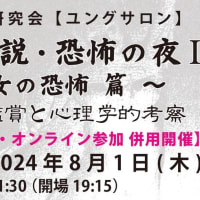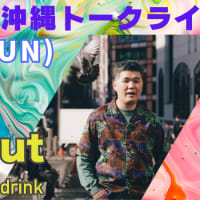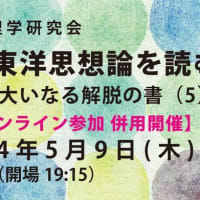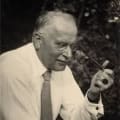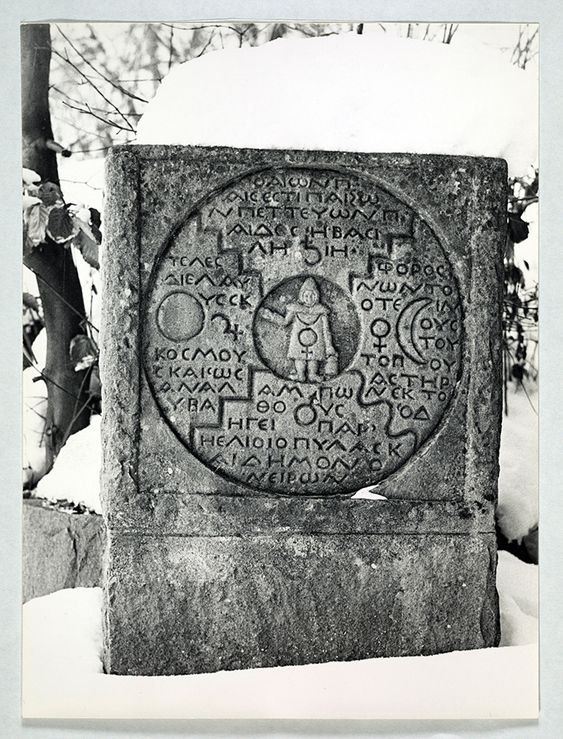
1950 年、ユングは 75 歳の誕生日を記念して、ボーリンゲン塔のすぐ西の湖岸に立方体の石を設置し、その三面に碑文を刻みました。 片面には、ロザリウムの哲学からの引用が含まれています。
Hic lapis exilis extat、pretio quoque vilis、spernitur a sultis、amatur plus ab edoctis。 (ここに卑劣で醜い石が立っています。「価格は非常に安いです! 愚か者に軽蔑されるほど、賢者に愛されます。)
石のこちら側にも献辞が刻まれています。
IN MEMORIAM NAT[ivitatis] S[uae] DIEI LXXV C G JUNG EX GRAT[itudine] FEC[it] ET POS[uit] A[nn]O MCML (75 歳の誕生日を記念して、C.G. ユングは感謝の気持ちを込めて作成および設定しました) 1950年に完成しました。)
立方体の2番目の面には、ランタンを持ち、フード付きのマントを着たユングのテレスフォロスの姿が描かれています。 それはギリシャ語の碑文に囲まれています:
「イオンは遊んで飛んでいる。女王は子供だ」; テレスフォロスは世界の暗い場所に浸透し、深さから輝く星のように「エリオウスの門と夢の悪魔」に導きます。
「時間は子供だ――子供らしく遊ぶ――ボードゲームをする――子供の王国だ。これは、この宇宙の暗い領域を歩き回り、深層から星のように輝くテレスフォロスだ。彼は、への道を指し示している」 太陽の門と夢の国へ。」
「時間は遊びやギャンブルをする子供のようなものであり、子供のものは王権である」はヘラクレイトスのものとされる断片です。
「彼は太陽の門と夢の国への道を指し示す」はオデュッセイアからの引用です(第24巻第12節)。 それは、殺された求婚者の魂を連れ去るサイコポンプのヘルメスを指します。
2 番目の面には、錬金術的に重要な 4 つの部分からなるマンダラも含まれています。 マンダラの上四分の一は土星、下四分の一は火星、左四分の一はソル・ジュピター(男性)、右四分の一はルナ・ヴィーナス(女性)に捧げられています。
立方体の 3 番目の面は湖に面する面です。 そこにはラテン語で格言が刻まれており、ユングによれば「多かれ少なかれ錬金術からの引用である」という。
碑文には次のように書かれています。
私は孤児で、一人です。 それにもかかわらず、私はどこにでもいます。 私もその一人ですが、自分とは反対です。 私は若者であると同時に老人でもあります。 私は父親も母親も知りません。なぜなら、私は魚のように深いところから引き上げられるか、白い石のように天から落ちなければならなかったからです。 私は森や山の中を歩き回りますが、人間の最も奥深い魂の中に隠れています。 私は誰にとっても死すべき存在ですが、時間のサイクルには影響されません。
インテリジェントディープウェブ
Hic lapis exilis extat、pretio quoque vilis、spernitur a sultis、amatur plus ab edoctis。 (ここに卑劣で醜い石が立っています。「価格は非常に安いです! 愚か者に軽蔑されるほど、賢者に愛されます。)
石のこちら側にも献辞が刻まれています。
IN MEMORIAM NAT[ivitatis] S[uae] DIEI LXXV C G JUNG EX GRAT[itudine] FEC[it] ET POS[uit] A[nn]O MCML (75 歳の誕生日を記念して、C.G. ユングは感謝の気持ちを込めて作成および設定しました) 1950年に完成しました。)
立方体の2番目の面には、ランタンを持ち、フード付きのマントを着たユングのテレスフォロスの姿が描かれています。 それはギリシャ語の碑文に囲まれています:
「イオンは遊んで飛んでいる。女王は子供だ」; テレスフォロスは世界の暗い場所に浸透し、深さから輝く星のように「エリオウスの門と夢の悪魔」に導きます。
「時間は子供だ――子供らしく遊ぶ――ボードゲームをする――子供の王国だ。これは、この宇宙の暗い領域を歩き回り、深層から星のように輝くテレスフォロスだ。彼は、への道を指し示している」 太陽の門と夢の国へ。」
「時間は遊びやギャンブルをする子供のようなものであり、子供のものは王権である」はヘラクレイトスのものとされる断片です。
「彼は太陽の門と夢の国への道を指し示す」はオデュッセイアからの引用です(第24巻第12節)。 それは、殺された求婚者の魂を連れ去るサイコポンプのヘルメスを指します。
2 番目の面には、錬金術的に重要な 4 つの部分からなるマンダラも含まれています。 マンダラの上四分の一は土星、下四分の一は火星、左四分の一はソル・ジュピター(男性)、右四分の一はルナ・ヴィーナス(女性)に捧げられています。
立方体の 3 番目の面は湖に面する面です。 そこにはラテン語で格言が刻まれており、ユングによれば「多かれ少なかれ錬金術からの引用である」という。
碑文には次のように書かれています。
私は孤児で、一人です。 それにもかかわらず、私はどこにでもいます。 私もその一人ですが、自分とは反対です。 私は若者であると同時に老人でもあります。 私は父親も母親も知りません。なぜなら、私は魚のように深いところから引き上げられるか、白い石のように天から落ちなければならなかったからです。 私は森や山の中を歩き回りますが、人間の最も奥深い魂の中に隠れています。 私は誰にとっても死すべき存在ですが、時間のサイクルには影響されません。
インテリジェントディープウェブ
生成AI
サイコポンプ(Psychopomp)には、次のような意味があります。
ギリシャ語で「魂の道標」を意味し、多くの宗教で死後の故人の魂を護衛する存在を指す言葉。故人を裁くのではなく、安全な通り道を提供するのが役割。
次元界全てへの魂の運搬を手伝う存在で、中立者という特別な地位を享受している。
In 1950, on the occasion of his 75th birthday, Jung set up a stone cube on the lakeshore, just west of the Bollingen Tower, inscribing it on three sides. One side contains a quote taken from the Rosarium philosophorum:
Hic lapis exilis extat, pretio quoque vilis, spernitur a stultis, amatur plus ab edoctis. (Here stands the mean, uncomely stone, 'Tis very cheap in price! The more it is despised by fools, The more loved by the wise.)
A dedication is also inscribed on this side of the stone:
IN MEMORIAM NAT[ivitatis] S[uae] DIEI LXXV C G JUNG EX GRAT[itudine] FEC[it] ET POS[uit] A[nn]O MCML (In memory of his 75th birthday, C.G. Jung out of gratitude made and set it up in the year 1950.)
The second side of the cube depicts Jung's Telesphoros figure, bearing a lantern and wearing a hooded cape. It is surrounded by a Greek inscription:
«Ὁ Αἰὼν παῖς ἐστι παίζων, πεττεύων· παιδὸς ἡ βασιληίη» · Τελεσφόρος διελαύνων τοὺς σκοτεινοὺς τοῦ κόσμου τόπους, καὶ ὡς ἀστὴρ ἀναλάμπων ἐκ τοῦ βάθους, ὁδηγεῖ «παρ' Ἠελίοιο πύλας καὶ δῆμον ὀνείρων».
"Time is a child — playing like a child — playing a board game — the kingdom of the child. This is Telesphoros, who roams through the dark regions of this cosmos and glows like a star out of the depths. He points the way to the gates of the sun and to the land of dreams."
"Time is a child at play, gambling; a child's is the kingship" is a fragment attributed to Heraclitus.
"He points the way to the gates of the sun and to the land of dreams" is a quote from the Odyssey (Book 24, Verse 12). It refers to Hermes the psychopomp, who leads away the spirits of the slain suitors.
The second side also contains a four-part mandala of alchemical significance. The top quarter of the mandala is dedicated to Saturn, the bottom quarter to Mars, the left quarter to Sol-Jupiter [male], and the right quarter to Luna-Venus [female].
The third side of the cube is the side that faces the lake. It bears a Latin inscription of sayings which, Jung says, "are more or less quotations from alchemy."
The inscription reads:
I am an orphan, alone; nevertheless I am found everywhere. I am one, but opposed to myself. I am youth and old man at one and the same time. I have known neither father nor mother, because I have had to be fetched out of the deep like a fish, or fell like a white stone from heaven. In woods and mountains I roam, but I am hidden in the innermost soul of man. I am mortal for everyone, yet I am not touched by the cycle of time.
Hic lapis exilis extat, pretio quoque vilis, spernitur a stultis, amatur plus ab edoctis. (Here stands the mean, uncomely stone, 'Tis very cheap in price! The more it is despised by fools, The more loved by the wise.)
A dedication is also inscribed on this side of the stone:
IN MEMORIAM NAT[ivitatis] S[uae] DIEI LXXV C G JUNG EX GRAT[itudine] FEC[it] ET POS[uit] A[nn]O MCML (In memory of his 75th birthday, C.G. Jung out of gratitude made and set it up in the year 1950.)
The second side of the cube depicts Jung's Telesphoros figure, bearing a lantern and wearing a hooded cape. It is surrounded by a Greek inscription:
«Ὁ Αἰὼν παῖς ἐστι παίζων, πεττεύων· παιδὸς ἡ βασιληίη» · Τελεσφόρος διελαύνων τοὺς σκοτεινοὺς τοῦ κόσμου τόπους, καὶ ὡς ἀστὴρ ἀναλάμπων ἐκ τοῦ βάθους, ὁδηγεῖ «παρ' Ἠελίοιο πύλας καὶ δῆμον ὀνείρων».
"Time is a child — playing like a child — playing a board game — the kingdom of the child. This is Telesphoros, who roams through the dark regions of this cosmos and glows like a star out of the depths. He points the way to the gates of the sun and to the land of dreams."
"Time is a child at play, gambling; a child's is the kingship" is a fragment attributed to Heraclitus.
"He points the way to the gates of the sun and to the land of dreams" is a quote from the Odyssey (Book 24, Verse 12). It refers to Hermes the psychopomp, who leads away the spirits of the slain suitors.
The second side also contains a four-part mandala of alchemical significance. The top quarter of the mandala is dedicated to Saturn, the bottom quarter to Mars, the left quarter to Sol-Jupiter [male], and the right quarter to Luna-Venus [female].
The third side of the cube is the side that faces the lake. It bears a Latin inscription of sayings which, Jung says, "are more or less quotations from alchemy."
The inscription reads:
I am an orphan, alone; nevertheless I am found everywhere. I am one, but opposed to myself. I am youth and old man at one and the same time. I have known neither father nor mother, because I have had to be fetched out of the deep like a fish, or fell like a white stone from heaven. In woods and mountains I roam, but I am hidden in the innermost soul of man. I am mortal for everyone, yet I am not touched by the cycle of time.
「これはテレスフォラスです。この宇宙の暗い領域を歩き回り、深層から星のように輝きます。彼は太陽の門と夢の国への道を示します。」
CG ユング、オーファン・ストーン
"This is Telesphorus, who roams through the dark regions of this cosmos and glows like a star out of the depths. He points the way to the gates of the sun and to the land of dreams."
C.G. Jung, Orphan Stone
CG ユング、オーファン・ストーン
"This is Telesphorus, who roams through the dark regions of this cosmos and glows like a star out of the depths. He points the way to the gates of the sun and to the land of dreams."
C.G. Jung, Orphan Stone
ユングの建築家たちが拒否した石
『家造りの捨てた石が、隅の親石になった』(詩編118・22) ルカ福音書二○章九ー一八節
ユングの 75 歳の誕生日石に描かれている人物、テレスフロスとは誰ですか?

岩を打って水を出すモーセ(「メリバの水」(民数記20:1~13))
私はロックハウンドグループにカール・ユングの名言を投稿して、引用のせいでみんなを困らせるのが大好きです😂
「この石は、決して失われることも溶解することもできない永遠のもの、ある人は自分の魂の中での神の神秘的な体験に喩える永遠のものを象徴していました。
それはおそらく最も単純で最も深い経験、つまり人間が不滅で不変であると感じる瞬間に得られる永遠のものの経験を象徴しています。」 - カール・ユング博士、人間とその象徴
I love posting Carl Jung quotes in rockhounding groups and getting people all bothered because a quote😂
"The stone symbolized something permanent that can never be lost or dissolved, something eternal that some have compared to the mystical experience of God within one’s own soul.
It symbolizes what is perhaps the simplest and deepest experience, the experience of something eternal that man can have in those moments when he feels immortal and unalterable .” - Dr. Carl Jung, Man and His Symbols
「この石は、決して失われることも溶解することもできない永遠のもの、ある人は自分の魂の中での神の神秘的な体験に喩える永遠のものを象徴していました。
それはおそらく最も単純で最も深い経験、つまり人間が不滅で不変であると感じる瞬間に得られる永遠のものの経験を象徴しています。」 - カール・ユング博士、人間とその象徴
I love posting Carl Jung quotes in rockhounding groups and getting people all bothered because a quote😂
"The stone symbolized something permanent that can never be lost or dissolved, something eternal that some have compared to the mystical experience of God within one’s own soul.
It symbolizes what is perhaps the simplest and deepest experience, the experience of something eternal that man can have in those moments when he feels immortal and unalterable .” - Dr. Carl Jung, Man and His Symbols
「ちょっと変わった色や形の石を拾って保管することを我慢できない人も多いのですが…。 なぜそうするのかもわからないまま。 まるで石には、人々を魅了する神秘が秘められているかのようです。
人類は太古の昔から石を集めてきましたが、明らかに、特定の石がすべての謎を秘めた生命力の魂の容器であると考えてきました。」 - カール・ユング博士、人間とその象徴
“Many people cannot refrain from picking up stones of a slightly unusual color or shape and keeping them, …. without knowing why they do. It is as if the stone held a mystery in it that fascinates them.
Men have collected stones since the beginning of time and have apparently assumed that certain ones were the containers of the the spirit of the life-force with all its mystery.” - Dr. Carl Jung, Man and His Symbols
人類は太古の昔から石を集めてきましたが、明らかに、特定の石がすべての謎を秘めた生命力の魂の容器であると考えてきました。」 - カール・ユング博士、人間とその象徴
“Many people cannot refrain from picking up stones of a slightly unusual color or shape and keeping them, …. without knowing why they do. It is as if the stone held a mystery in it that fascinates them.
Men have collected stones since the beginning of time and have apparently assumed that certain ones were the containers of the the spirit of the life-force with all its mystery.” - Dr. Carl Jung, Man and His Symbols






